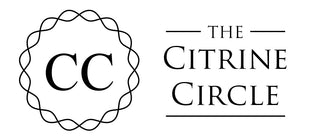Citrine is a crystal that is well known to many people, it's sunny energy and popularity as a crystal that attracts prosperity and abundance makes it a firm favourite among many. What you might not know however, is that about 95% of the Citrine on the market is actually heat treated Amethyst, or "fake" Citrine. To create heat treated Citine (also called burnt Amethyst), an Amethyst crystal is baked at temperatures of around 800-900 degrees Farenheit, this changes the colour to deepening shades of orange, depending on how long it is "cooked" for.

It can be quite difficult at first to know what you're buying, as most shops don't label their crystals as heat treated Amethyst, and even now, many crystal authors still have photos of burnt Amethyst crystals labelled as Citrine. Once you learn a few key points however, you will easily be able to tell them apart.
1. The Main Colour
Natural Citrine can vary from a very pale yellow shade, almost green in colour, such as Congo Citrine (also called Kundalini Citrine), to a stronger deep, often smokey yellow such as the long crystals from Zambia. Natural Citrine is hardly ever a deep burnt yellow-orange colour, this is almost always burnt Amethyst, although there are exceptions.
2. The Base Colour
Natural Citrine crystals are the same colour all the way through for the most part, though there may be slight colour variations in the crystal. Heat Treated Citrine will often have opaque white in it, usually at the base, which is a tell-tale sign of a heated crystal due to it's original Amethyst form.
 3. The Crystal Formation
3. The Crystal Formation
Natural Citrine tends to grow in single crystals or small clusters of a few crystals, and never in a geode form. You will often see geodes of varying sizes that look suspiciously like orange Amethyst, this is exactly what they are.
Here are some images of Citrine being sold by retailers that are actually ALL heat treated Amethyst:

Notice how the bright orange/yellow colour is not even, there is the white base of the crystal, and that the formations look exactly the same as an Amethyst crystal?
Here are some pictures of Natural Citrine from different regions:

Notice how the colour of these Citrine crystals is much lighter and more of a greeny shade? The first and last pictures are Citrine from the Congo, the second picture is Citrine from Zambia, two of the most famous natural Citrine localities.
All of the Citrine we sell is natural, and mostly from the Congo and Zambia. Many crystal healers say it doesn't matter whether your Citrine is natural or heat treated Amethyst, but personally I believe that both Citrine and Amethyst are amazing crystals in their natural forms, and I would rather have them in the colour nature created them. Hopefully this article has helped to show the difference between the two crystals, if it has, please share it to help spread the knowledge!


 3. The Crystal Formation
3. The Crystal Formation
Ron
Looking for help identifying small cluster of yellow crystals. They scratch glass and metal. Found in yard when excavating for septic. Excavator scraping solid Stone.There are bubbles in rock in Stone bottom creek that have crystals under them but not yellow. There are both quarts crystals and what I think is calcite soft crystals in those bubbles. Sedimentary rock. Old ocean floor. Can find fossilized sponges and geodes. The crystals are brilliant yellow and very sparkly tiny but pretty evenly sized. I cut in half and made two charms from. Only a couple inches in size cluster. It is the only yellow crystals that I found on my property. Crystal’s on a rusty collard sedimentary soft Stone. Appear to be pointy-topped crystals four-sided maybe cubicle. There is no length to them. Vinegar does not hurt them I wear them in shower all the time no problems. I would appreciate any help you could give me.
Sean
Is citrine sphere real? I’ve seen numerous times the size of almost size 5 soccer ball…. Can real citrine be that?
Diana
I’ve been at a market this morning and there were a few vendors selling gemstones, among them they had citrine. So one of them was selling a very dark citrine that looked to me like Smokey quartz. He said it was natural, non-heated citrine. I know there is such thing as Smokey citrine. Hmmm! I bought one but I’m not sure it’s really citrine. Another vendor was selling citrine towers, which looked to me like real, genuine citrine, light yellowish-greenish throughout, like the Congo ones. I asked him if they were non-heated and he said “of course they’re heated, those natural ones are extremely rare and very expensive”. That was his answer. I was a bit shocked because those citrine towers had every single natural citrine characteristic I could find on my online search….including this website. Now I’m even more confused!
Csaba
Thank you for this informative post on Citrine crystals! I had no idea that the majority of Citrine on the market is actually heat treated Amethyst. It’s concerning that many retailers do not label their crystals correctly, making it difficult for consumers to know what they are buying. In this article it says that there are differences in the metaphysical properties of Citrine and heat treated Amethyst, what do you think, is this true? My question is, what are some other crystals that are commonly heat treated or altered in some way to enhance their appearance? I’m curious to learn more about how crystals are treated before they make it to the market.
MyCrazyCat
I appreciate when sellers are honest and knowledgeable about what they are selling. I have had experiences with crystal sellers trying to sell me irradiated quartz as natural citrine. When I questioned them they were very defensive and called me a citrine snob. I was told that just because it was heat treated by man didn’t make it not citrine. Uh…i won’t buy from them, needless to say.
Now that crystal lucky scoops are booming on Tiktok, a lot of people new to crystals are reselling these low quality, heat treated amethyst and irradiated quartz as natural citrine because they honestly don’t know better.
I totally appreciate you explaining the difference so succinctly. It makes it a much more pleasurable experience to purchase from a knowledgeable and honest seller.